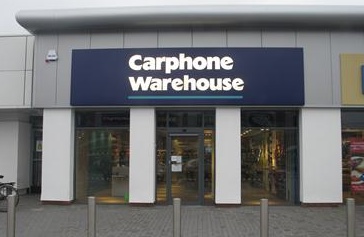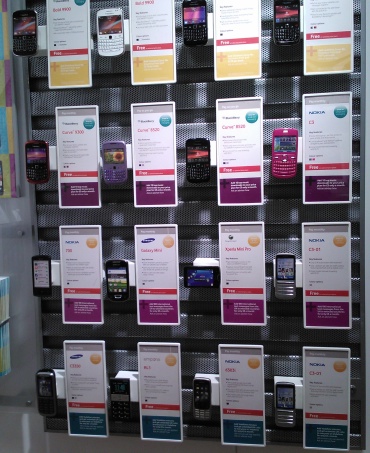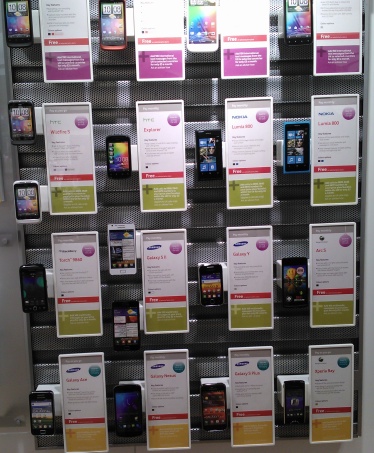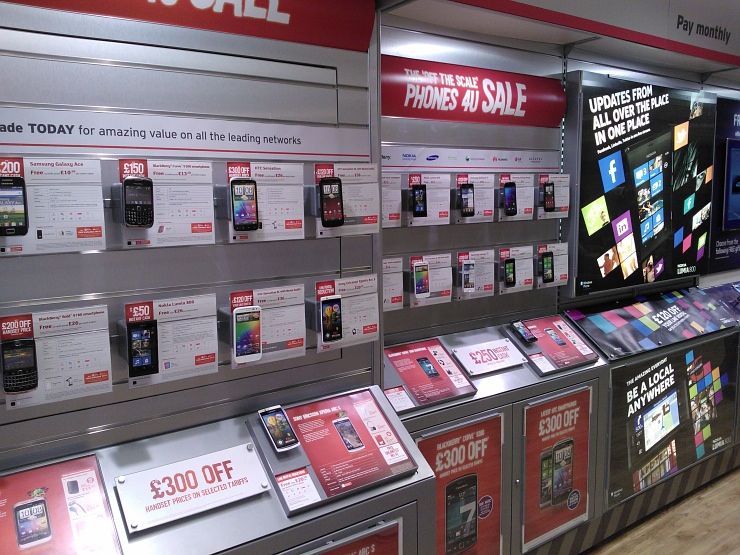Published by Steve Litchfield at 7:13 UTC, January 9th 2012
Feeling a little like a TV undercover 'mystery shopper', I picked a UK provincial town and worked my way through their High Street phone outlets. I wanted to get a snapshot of how Symbian was (or wasn't) being represented in the place from which most people acquire phones in this nation. In the process, I was somewhat shocked. However much as some geeks like to attribute failing Symbian sales per quarter to 'technical deficiencies' or 'lack of apps' (both of which are somewhat over-exaggerated), there's a far simpler explanation...
Here then, is my impromptu UK High Street tour, as at January 2012. In no particular order:
 Carphone Warehouse
Carphone Warehouse
Around a hundred handsets on display (including all the really low end ones), among which were a mere three powered by Symbian. Two years ago, this number was around a dozen. The Nokia 700 was there, a fairly charming little Symbian Belle device; the N8 was there - still rated by everyone, it seems, even 14 months on, because of the camera; and, looking incredibly sad, the bottom part of a Nokia E7.
You read that right. Just the bottom bit. Someone had managed to break the top, hinged part of the display dummy and, rather than replace the unit, the staff had just left the broken E7 dummy on the stand. I mentioned this to the staff and they shrugged, with a look suggesting noone was asking about the phone and they wouldn't recommend it, so what was the point.
I chatted to the staff, mentioning a technical problem with the settings on my (Windows Phone-powered Lumia 800) just in case they had any ideas and the guy's off the cuff reaction was "Well, [what do you expect], it's a Nokia". The implication was that they saw Nokias (seemingly of any platform persuasion) as being troublesome and hard to set up. Which of course is total nonsense - other phone platforms and hardware have setup and configuration problems too - this was simply a learned bias against Nokia and, as demonstrated by the broken E7, very sad to see.
O2
My time in this shop was limited because there were no actual customers and the sales guy insisted on chatting, so we talked about the Lumia 800 (I'll cover this in a short editorial on AAWP). The N8 was again on sale, along with the qwerty E5 and the new 700. Somewhat lost in a sea of larger-screened Android handsets, but they were there. No sign of the E6 or X7 or E7 or C6-01, all of which seem to have died a death in phone shops.
Vodafone
A handful of customers buying stuff meant that I didn't get a chance to talk to any of the staff, but I did snap their (non-budget) phone range for you:


Only the Nokia 700 was being shown of all the Symbian handsets. Not even the mighty N8 was on display. There was an overwhelming display of every single HTC and Samsung Android variant, plus a smattering of Blackberrys and some feature phones. Is this really all that people want?
Phones 4U
Worse was to come, popping into this shop, I couldn't find a single handset in the entire shop that ran Symbian. No N8, no Nokia 700. Just a wall of Android slabs, punctuated by the odd Blackberry. Plus a large Lumia 800 display (plus a couple of Lumia dummies and a working example elsewhere). But no Symbian.

It's as if, for Phones 4U, Symbian had simply ceased to exist. Never mind that the N8 can wipe the floor with any of cameras on the phones displayed, never mind that the E7's form factor is utterly unique, never mind the E6 with its three day battery life, never mind the C7, one of the most beautiful smartphones ever made. Etc. Oh no, the High Street has decided, it seems, that people aren't even going to be offered the chance to buy Symbian.
Orange
Just the N8 was on display, in this dark and (perennially deserted of customers, in my experience, in this particular town) rather oppressive shop. The staff were chatty, mind you - not surprising, as I was the only person to darken their door in the 10 minutes I was in the shop...
_____________________
At this point, it becomes blindingly clear why sales of Symbian handsets in Europe have dipped dramatically in the last nine months - the shops, both independent and network-run, are drastically limiting the number of Symbian-powered phones on display. I cannot remember the last time I went into any phone shop and saw a Symbian-powered handset being promoted in any kind of special way. [Ok, I can, it was the N8 about a year ago, but that's an eternity in the phone world]
Possible reasons for this mix of apathy and rejection towards Symbian:
- return rates by customers in the infamous 'N97 era' (2010) were too high for comfort and soured the shops towards Symbian forever
- following the February 11th 2011 announcements, the network and phone shop 'buyers' all firmly got the (IMHO miscommunicated) message that Symbian was going to be phased out and therefore was no longer to be 'recommended'. Never mind that the phasing out was going to take two or three years...
- after years of Symbian dominance (especially back in 2007/2008), the networks and shops wanted a sea change - the wealth of Android phones at all price ranges meant that Symbian could simply be swapped for Android in terms of shelf space
I suspect there's an element of truth to all three theories, but the combination has been somewhat catastrophic for Symbian in the shops.
[ Actually, I do have another, ancillary, theory, which is that the very point of smartphones has changed dramatically since about 2008, driven by the iPhone and now large screened Android tablets, more geared towards people consuming content (music/video/web/social), whereas back in Symbian's heyday the smartphones sold far more to technophiles who leaned more towards creating content (especially photos/text/video).
It's instructive to note that, despite being overtaken in worldwide smartphone sales per quarter, Nokia still sells getting on for twenty million smartphones in each period, not dissimilar to sales figures three years ago - and that the number of people who have bought N8s, for example, is probably also not dissimilar to the number who bought the N82 back in the day - in other words, the fraction of smartphone fans who love creating rather than consuming hasn't really changed.
So... it turns out that there are far more people who like consuming information than creating it. Duh - who knew?(!) ]
Eagle eyed readers will note that I haven't mentioned iPhone even in passing. The iPhone 4 and 4S sit apart from all of the above, both physically on shop shelves/displays and in terms of who's going to buy them. In my experience, anyone who decides they'd like (and can afford) an iPhone 4/4S will just buy it and there's little point in a salesman trying to compare it to Android, Blackberry or (heaven forbid) a Symbian smartphone. Likewise, someone who's already decided that they don't want (or can't afford) an iPhone 4/4S is unlikely to be persuaded, in the shop, that they're barking down the wrong tree.
(Plus large numbers of people simply buy their iPhones from the increasingly more numerous Apple shops, where there's more of a premium experience, unspoilt by legions of unsightly smartphones of other persuasions.)
It's hard to see how Symbian can make a comeback in Western Europe in terms of retail shops - there's just so much negativity in the presentation and attitude of the staff. I'd argue this is largely unjustified - but I doubt a voice of reason like mine, with technical arguments, would make a difference at this stage. I can chat to shop staff telling them that the Nokia N8 can do far more than 90% of the handsets they sell, but I'd quickly get dismissed as an annoyance - their minds are already made up. Staff know what they're going to recommend to everyone who walks in through the door and you can be sure it's not going to be Symbian.
All of which makes me both sad and angry. Then I remember that I already own a number of Symbian phones which serve my needs very well and which aren't going to suddenly stop working just because High Street shops stop selling them...
You can see why Nokia decided to drop the upfront Symbian name when referring to Belle though - telling the shops and networks that there's a new phone out with Android-like UI and with a UI that's named "Nokia Belle" may just sidestep the prejudice catalogued above.
Maybe.
It should be noted, in the interests of balance, that Symbian sales are holding up much better in other parts of the world, usually where overpriced £500 'superphones' are uneconomic and where shops do stock Symbian-powered smartphones and are (shock) prepared to sell them to customers.
What will 2012 hold for Symbian? Watch for predictions on this site and on our regular podcast!
Steve Litchfield, All About Symbian, 9 January 2012
blog comments powered by Disqus
No hay comentarios:
Publicar un comentario